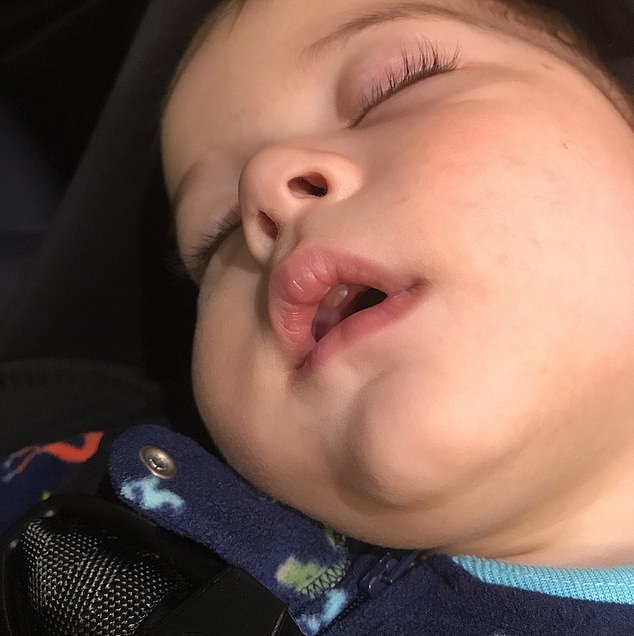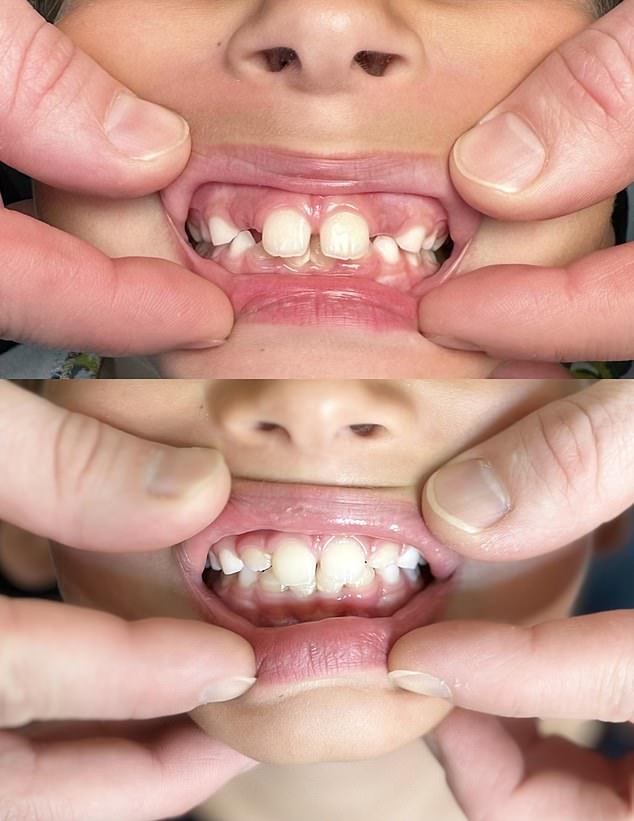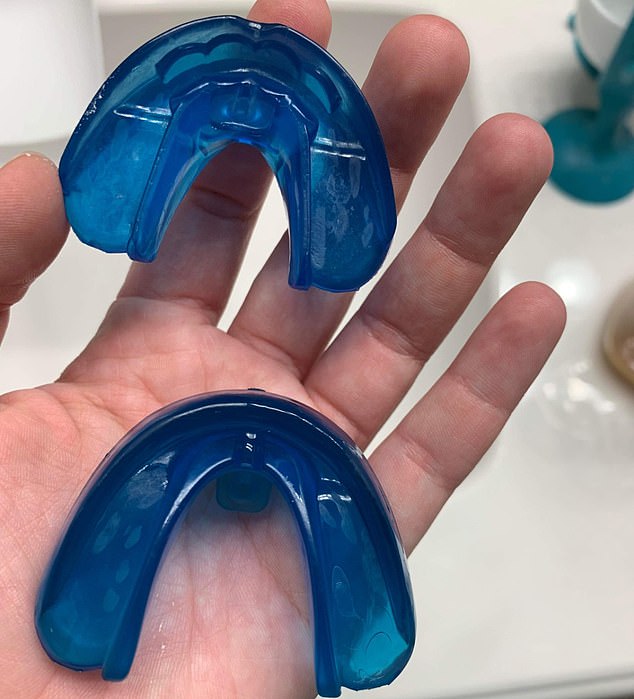Subtle symptom on boy’s face betrayed he was suffering from silent medical emergency
A Texas mother is urging parents to be aware of a common breathing habit that could have lifelong consequences for their children.
Soshanna Deyette of Austin spent years being misdiagnosed by doctors who struggled to figure out what was causing her son’s seemingly unrelated symptoms.
Tab was mute until he started kindergarten. He barely slept and had erratic outbursts.
Ms Deyette suspected autism and a doctor diagnosed Tab, now seven, with attention deficit disorder (ADHD). Another doctor suggested it was all in his head.
It wasn’t until Mrs. Deyette was referred to a specialist that the family finally got answers: Tab was a “mouth breather.”
Soshanna Deyette’s son, Tab, was finally diagnosed and treated when doctors noticed his underdeveloped jaw (left). He is pictured on the right after treatment
The doctor noticed that Tab’s cheekbones were faint, his jawline was set back, and his chin was retracted, all of which are hallmark symptoms of chronic mouth breathing.
It happens when someone takes in oxygen primarily through the mouth instead of the nose. Six out of ten Americans do this.
But it can have devastating effects on children’s development, as it limits the amount of oxygen the body can take in and use to grow.
It also limits the amount of oxygen getting to the brain, which can slow neurological development.
If severe enough, mouth breathing can also make it difficult to sleep, which is crucial in the early stages of a child’s growth.
The airways become narrowed, leading to snoring, sniffling or sudden waking up.
Mrs Deyette said: ‘The first year of his life I didn’t even realise anything was wrong.
“But looking back and looking at the videos and pictures, he’s always had some degree of breathing difficulty. I assumed it was mucus and that’s why he couldn’t breathe at night.
“He always had his mouth open. In all of his videos, you hear this snorting, gurgling… like the airways are trying to breathe.”
Mouth breathing can change the position of the tongue, which is important for facial growth.
If left untreated, children may develop a flatter face, less prominent cheekbones and drooping eyes.
They may also have lower facial muscle tone and wider dental arches.
Mouth breathing can also lead to dry mouth, which decreases saliva production and increases the risk of tooth decay and gum disease.
Between 10 percent and half of children have it, with varying degrees of severity. Most grow out of it, according to a report from the National Library of Medicine.
When Tab was 18 months old, Mrs. Deyette noticed that she was not speaking much, was acting confused and “had a stuffy nose, was breathing through her mouth and snoring.”
Her son’s snoring could be heard through a closed door, on a sound machine in the boys’ room, and on the television in the living room.
At the age of two and a half, he barely spoke and received speech therapy.
Mrs. Deyette said, “I took him back and had him tested for autism. I wanted answers to what was wrong with my child.
‘He was in this “La La Land”, in his own world and completely cut off from everything.
“I asked our pediatrician and I remember her taking her scope, looking at his mouth and (she) saw nothing. There were no blockages.”

Tabs snoring could be heard through a closed door and via a sound machine and television

Mrs. Deyette took her son to speech therapy and had him tested for autism
After changing GPs, Mrs Deyette was referred to an ENT specialist who told her that Tab was suffering from a double ear infection.
She was told that his adenoids (small glands behind the nose) covered 90 percent of his airway and were preventing him from breathing through his nose.
After his tonsils were removed, his symptoms improved, but that was only part of the problem.
Ms. Deyette described Tab’s transformation as a “word explosion.” He began to speak better and act more like a child.
But it wasn’t long before the boy’s symptoms returned, although they were much milder than before.
Mrs Deyette shared in an Instagram post: ‘His breathing remained labored. His snoring returned.
‘He had been suffering from respiratory ailments for years.’
The damage to Tab’s face from years of breathing incorrectly was still having an effect.
In collaboration with a dental team, the family was prescribed a device similar to a sports mouthguard. It forces the tongue to press firmly against the roof of the mouth, forcing people to breathe through their nose.
Known as the ToothPillow, it ‘helps guide natural growth and development, reducing the damaging effects of modern living on the mouth, jaws and respiratory tract.’
So far, the ToothPillow device has only proven effective for people who are still in their formative years, namely between the ages of three and twelve. People outside of this age range should look for alternative methods.

Tab was eventually fitted with a device that resembled a mouthguard to keep his tongue in his mouth properly

The device, known as the ToothPillow, “helps guide natural growth and development, and mitigates the damaging effects of modern living on the mouth, jaws and airways.”
In addition to ToothPillow, chronic mouth breathers can also undergo myofunctional therapy to strengthen the tongue and orofacial muscles. This teaches the muscles to assume the correct position, which in turn promotes healthier nasal breathing.
There are several reasons why a child may breathe through the mouth instead of the nose. One possible explanation given by experts is a soft diet in early childhood.
An early soft diet prevents muscle fiber growth, which weakens the tongue and affects the development of the mouth. This leads to more crowding of permanent teeth, according to research conducted by Dr. James Sim Wallace, a dentist.
Four hundred years ago, there were no underdeveloped jaws and teeth that were crowded together.
Breastfeeding was traditionally followed by a diet of hard foods, which resulted in perfectly formed upper and lower jaws.
However, today it is common for growing children to eat soft foods, relying on bottle feeding, pacifiers, soft baby foods and shorter breastfeeding duration.
And if the jaw cannot fully develop, there is a chance that children will breathe through their mouth.
Research has also shown that mouth breathing in children is associated with an increased risk of ADHD, bedwetting, tonsillitis, adenoids, asthma, and allergies.
